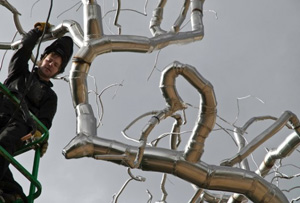
 At 45 feet high by 45 feet wide, Graft (2008–2009) by American sculptor Roxy Paine stands out among the trees in the Sculpture Garden of the National Gallery of Art, one-half mile from the United States Capitol on the National Mall. The Gallery commissioned Paine to make a "Dendroid," as the artist calls his series of treelike sculptures, for the Sculpture Garden. The newly installed work is the first by Paine to enter the Gallery's collection, as well as the first contemporary sculpture to be installed in the Sculpture Garden in the 10 years since it opened.
At 45 feet high by 45 feet wide, Graft (2008–2009) by American sculptor Roxy Paine stands out among the trees in the Sculpture Garden of the National Gallery of Art, one-half mile from the United States Capitol on the National Mall. The Gallery commissioned Paine to make a "Dendroid," as the artist calls his series of treelike sculptures, for the Sculpture Garden. The newly installed work is the first by Paine to enter the Gallery's collection, as well as the first contemporary sculpture to be installed in the Sculpture Garden in the 10 years since it opened.
Made from more than 8,000 components, the stainless steel structure—which weighs approximately 16,000 pounds—was installed the week of October 26–30 by Paine and his crew. The 43-year-old artist has shown his other Dendroids on the roof of the Metropolitan Museum of Art (New York), in the Olympic Sculpture Park (Seattle), and outside the Museum of Modern Art (Fort Worth, Texas), among other locations.
"Paine's Graft is uniquely appropriate for the Sculpture Garden, which balances art and nature within the urban yet verdant setting of the nation's capital," said Earl A. Powell III, director, National Gallery of Art. "The Gallery is extremely grateful for the generosity of philanthropists Victoria Sant, president of the Gallery, and her husband, Roger Sant, who made this important addition to the collection of contemporary sculpture possible."
Graft presents two fictive but distinct species of trees—one gnarled, twisting, and irregular, the other smooth, elegant, and rhythmic—joined to the same trunk. Among its rich associations, this sculpture evokes the persistent human desire to alter and recombine elements of nature, as well as the ever-present tension between order and chaos.
Paine's first Dendroid, Impostor (1999), a 27-foot-tall sculpture, stands in a forest clearing at the Wanås Foundation in Knislinge, Sweden. Paine has since made 16 Dendroids, each unique and organized according to its own system. The works are installed in sylvan settings, urban environments, and landscaped urban parks. Trees have long been regarded a metaphor for human existence, and their forms evoke for Paine a range of natural and man-made systems from neurons to river networks, from taxonomic diagrams to genealogical charts.
Paine divides his sculptural practice along three visually distinct tracks: in addition to his Dendroids, he makes meticulous representations of plants and fungi modeled in polymer, which he calls Replicants. He also creates automated art-making machines that produce abstract paintings, sculptures, and drawings. These seemingly disparate forms all share a common interest in the distinction between reality and artifice, the natural and the man-made environment, raising questions about the limits of human control.
About the Artist
Roxy Paine was born in 1966 in New York and studied at the College of Santa Fe in New Mexico and the Pratt Institute in New York. Since 1990 his work has been internationally exhibited and is included in major collections such as De Pont Museum of Contemporary Art, Tilburg, the Netherlands; Hirshhorn Museum and Sculpture Garden, Washington, DC; Israel Museum, Jerusalem; Museum of Modern Art, New York; San Francisco Museum of Modern Art; and the Whitney Museum of American Art, New York. In addition to those mentioned, Paine's Dendroids can be found at various museums and foundations, including Montenmedio Arte Contemporaneo NMAC, Cadiz, Spain, and the St. Louis Art Museum, St. Louis, Missouri. Roxy Paine lives and works in Brooklyn and Treadwell, New York.
Organization: Organized by the National Gallery of Art.
Passes: Passes are not required for this exhibition.
On view in the National Gallery's Sculpture Garden.

